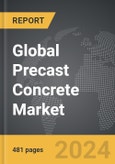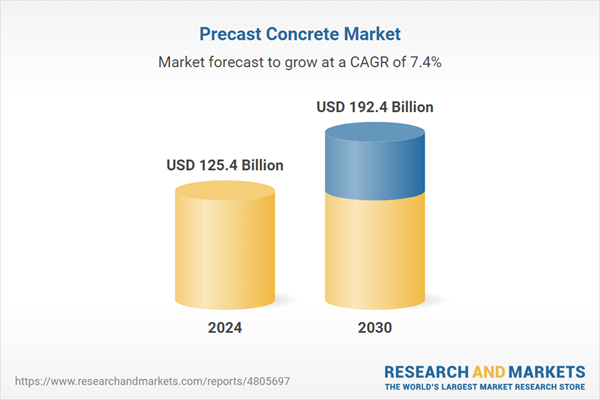Global Precast Concrete Market - Key Trends & Drivers Summarized
Precast concrete is a construction material produced by casting concrete in a reusable mold or form, which is then cured in a controlled environment and transported to the construction site for installation. This method offers several advantages over traditional cast-in-place concrete, including improved quality control, faster construction times, and reduced labor costs. Precast concrete components are used in a wide range of applications, including building facades, structural elements, bridges, and infrastructure projects. The versatility and durability of precast concrete make it a preferred choice for modern construction practices.The adoption of precast concrete is driven by the need for efficient and sustainable construction methods. Precast components can be manufactured to precise specifications, ensuring high quality and uniformity. This reduces the likelihood of construction errors and enhances the overall structural integrity of the project. Additionally, the controlled manufacturing environment allows for the incorporation of advanced materials and technologies, such as high-performance concrete and embedded sensors, to improve the performance and longevity of the structures. Precast concrete also offers environmental benefits, as it generates less waste and allows for the use of recycled materials.
The growth in the precast concrete market is driven by several factors. Firstly, the increasing demand for efficient and cost-effective construction methods to meet the growing urbanization and infrastructure development is a major driver. Secondly, advancements in precast concrete technologies, such as high-performance concrete and integrated sensors, are enhancing the durability and performance of precast components. Thirdly, the rising emphasis on sustainability and green building practices is encouraging the use of precast concrete due to its reduced waste generation and ability to incorporate recycled materials. Additionally, the need for faster construction times and reduced labor costs is propelling the adoption of precast concrete. Lastly, the expansion of infrastructure projects, including transportation, utilities, and commercial buildings, is further driving the demand for precast concrete components.
Report Scope
The report analyzes the Precast Concrete market, presented in terms of market value (USD). The analysis covers the key segments and geographic regions outlined below.- Segments: Element (Columns & Beams, Floors & Roofs, Walls & Barriers, Utility Vaults, Girders, Pipes, Other Elements); End-Use (Non-Residential, Residential).
- Geographic Regions/Countries: World; USA; Canada; Japan; China; Europe; France; Germany; Italy; UK; Spain; Russia; Rest of Europe; Asia-Pacific; Australia; India; South Korea; Rest of Asia-Pacific; Latin America; Argentina; Brazil; Mexico; Rest of Latin America; Middle East; Iran; Israel; Saudi Arabia; UAE; Rest of Middle East; Africa.
Key Insights:
- Market Growth: Understand the significant growth trajectory of the Non-Residential End-Use segment, which is expected to reach US$142.6 Billion by 2030 with a CAGR of 7.7%. The Residential End-Use segment is also set to grow at 6.7% CAGR over the analysis period.
- Regional Analysis: Gain insights into the U.S. market, valued at $22.3 Billion in 2024, and China, forecasted to grow at an impressive 9.5% CAGR to reach $58.9 Billion by 2030. Discover growth trends in other key regions, including Japan, Canada, Germany, and the Asia-Pacific.
Why You Should Buy This Report:
- Detailed Market Analysis: Access a thorough analysis of the Global Precast Concrete Market, covering all major geographic regions and market segments.
- Competitive Insights: Get an overview of the competitive landscape, including the market presence of major players across different geographies.
- Future Trends and Drivers: Understand the key trends and drivers shaping the future of the Global Precast Concrete Market.
- Actionable Insights: Benefit from actionable insights that can help you identify new revenue opportunities and make strategic business decisions.
Key Questions Answered:
- How is the Global Precast Concrete Market expected to evolve by 2030?
- What are the main drivers and restraints affecting the market?
- Which market segments will grow the most over the forecast period?
- How will market shares for different regions and segments change by 2030?
- Who are the leading players in the market, and what are their prospects?
Report Features:
- Comprehensive Market Data: Independent analysis of annual sales and market forecasts in US$ Million from 2024 to 2030.
- In-Depth Regional Analysis: Detailed insights into key markets, including the U.S., China, Japan, Canada, Europe, Asia-Pacific, Latin America, Middle East, and Africa.
- Company Profiles: Coverage of players such as Boral Ltd., CRH PLC, Cemex S.A.B. de C.V., Aggregate Industries Ltd., Contech Engineered Solutions LLC and more.
- Complimentary Updates: Receive free report updates for one year to keep you informed of the latest market developments.
Some of the 91 companies featured in this Precast Concrete market report include:
- Boral Ltd.
- CRH PLC
- Cemex S.A.B. de C.V.
- Aggregate Industries Ltd.
- Contech Engineered Solutions LLC
- Balfour Beatty PLC
- Bouygues Construction
- Coltman Precast Concrete Limited
- Concrete Pipe and Precast LLC
- A.J. Foss, Inc.
- Bonna Sabla
- Capital Precast, Inc.
- Barro Group
- Elematic Oyj
- Balcrom Limited
This edition integrates the latest global trade and economic shifts into comprehensive market analysis. Key updates include:
- Tariff and Trade Impact: Insights into global tariff negotiations across 180+ countries, with analysis of supply chain turbulence, sourcing disruptions, and geographic realignment. Special focus on 2025 as a pivotal year for trade tensions, including updated perspectives on the Trump-era tariffs.
- Adjusted Forecasts and Analytics: Revised global and regional market forecasts through 2030, incorporating tariff effects, economic uncertainty, and structural changes in globalization. Includes historical analysis from 2015 to 2023.
- Strategic Market Dynamics: Evaluation of revised market prospects, regional outlooks, and key economic indicators such as population and urbanization trends.
- Innovation & Technology Trends: Latest developments in product and process innovation, emerging technologies, and key industry drivers shaping the competitive landscape.
- Competitive Intelligence: Updated global market share estimates for 2025, competitive positioning of major players (Strong/Active/Niche/Trivial), and refined focus on leading global brands and core players.
- Expert Insight & Commentary: Strategic analysis from economists, trade experts, and domain specialists to contextualize market shifts and identify emerging opportunities.
Table of Contents
Companies Mentioned (Partial List)
A selection of companies mentioned in this report includes, but is not limited to:
- Boral Ltd.
- CRH PLC
- Cemex S.A.B. de C.V.
- Aggregate Industries Ltd.
- Contech Engineered Solutions LLC
- Balfour Beatty PLC
- Bouygues Construction
- Coltman Precast Concrete Limited
- Concrete Pipe and Precast LLC
- A.J. Foss, Inc.
- Bonna Sabla
- Capital Precast, Inc.
- Barro Group
- Elematic Oyj
- Balcrom Limited
Table Information
| Report Attribute | Details |
|---|---|
| No. of Pages | 481 |
| Published | January 2026 |
| Forecast Period | 2024 - 2030 |
| Estimated Market Value ( USD | $ 125.4 Billion |
| Forecasted Market Value ( USD | $ 192.6 Billion |
| Compound Annual Growth Rate | 7.4% |
| Regions Covered | Global |









